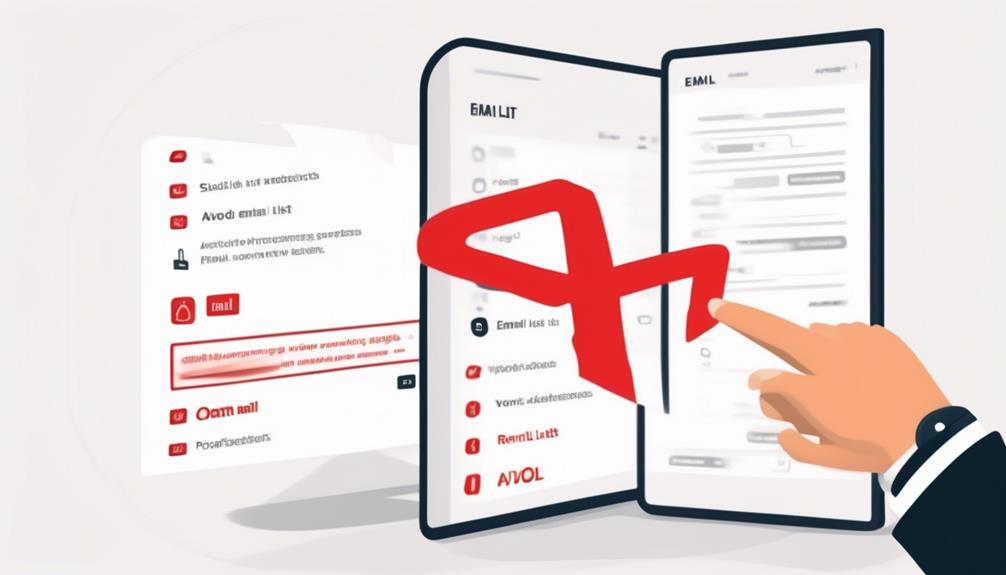As marketers, we understand the frustration of meticulously crafting a perfect email campaign, only for it to disappear into the vastness of the internet, unnoticed and unopened. It’s like shouting in a crowded room and getting no response.
So, how can we ensure that our emails not only reach their intended recipients but also land in their inboxes and entice them to open? Well, the answer lies in mastering the art of email deliverability.
By understanding the key factors that influence whether our emails make it to the inbox or get lost in the dreaded spam folder, we can significantly increase the effectiveness of our email marketing efforts. But how do we navigate this complex landscape of sender reputation, content relevance, and engagement?
Stay with us as we explore the top email deliverability tips that every marketer should have in their arsenal.
Key Takeaways
- Sender reputation is crucial for email deliverability and should be monitored and maintained consistently.
- Creating engaging and relevant content reduces the likelihood of emails being marked as spam.
- Subscriber engagement plays a significant role in email deliverability, and efforts should be made to improve and sustain engagement rates.
- Monitoring email performance metrics, such as open rates and bounce rates, and regularly assessing the health of the email list are essential for maintaining high deliverability.
Understanding Email Deliverability
Understanding email deliverability is crucial for marketers to ensure their messages successfully reach their intended recipients' inboxes. In the realm of email marketing, the ability to land in the primary inbox rather than the spam folder can make or break a campaign.
Sender reputation plays a pivotal role in email deliverability. It's a measure of the trustworthiness of the sender's IP address and domain. Monitoring and maintaining a good sender reputation is essential for high deliverability rates.
Additionally, the content of the email itself and the infrastructure used for sending emails also influence deliverability. Emails with engaging and relevant content are less likely to be marked as spam, thereby improving deliverability. Moreover, infrastructure elements like having proper SPF (Sender Policy Framework) records and utilizing feedback loops from email providers can significantly enhance deliverability.
Minimizing spam complaints by offering clear opt-out options and sending emails to only those who've opted in are also critical for maintaining high deliverability rates.
Mastering these nuances of email deliverability is indispensable for successful email marketing campaigns.
Importance of Email Deliverability

Improving email deliverability is a critical factor in achieving successful marketing campaigns. High email deliverability directly impacts the return on investment, customer engagement, and trust building. Maintaining good sender reputation, crafting relevant and valuable email content, and ensuring high-quality email lists are essential for achieving optimal email deliverability.
Sender reputation, email content, list quality, engagement rates, ISP filtering, and technical aspects significantly influence the deliverability of marketing emails. Neglecting these factors can lead to emails being marked as spam, ultimately jeopardizing the effectiveness of marketing efforts.
- Sender Reputation: A positive sender reputation is crucial for ensuring that marketing emails reach the intended recipients' inboxes.
- Email Content: Crafting relevant and valuable email content helps in avoiding spam filters and engaging recipients.
- List Quality: Maintaining high-quality email lists by employing double opt-in methods, regular list purging, and adhering to consistent send schedules is vital for achieving and maintaining high email deliverability.
In the fast-paced world of marketing, understanding and prioritizing email deliverability is crucial for ensuring that marketing messages effectively reach the target audience, fostering meaningful connections and driving desired actions.
Factors Affecting Email Deliverability
When it comes to email deliverability, the quality of our email content, our sender reputation, and the engagement of our subscribers are key factors.
These aspects directly impact whether our emails reach their intended recipients' inboxes.
Email Content Quality
Email content quality significantly impacts the deliverability of marketing emails, affecting their successful reach and engagement with recipients. To improve email deliverability, it's crucial to ensure that the email content meets certain standards. This includes:
- Relevant and Valuable Content: Crafting content that's valuable and relevant to the audience ensures higher engagement and reduces the likelihood of emails being diverted to the spam folder.
- Clear and Concise Messaging: Communicating the intended message clearly and concisely helps in maintaining the audience's interest and attention.
- Personalization and Segmentation: Tailoring emails to specific segments of the audience and personalizing the content can lead to a more engaged audience, thereby positively impacting deliverability.
Sender Reputation
Our sender reputation directly influences the deliverability of our marketing emails, impacting the success of our campaigns and engagement with recipients. Maintaining a positive sender reputation is crucial for achieving a high email deliverability rate.
Factors such as avoiding SPAM traps, adhering to best practices for email marketing, and consistently sending relevant and valuable content contribute to a favorable sender reputation. Additionally, actively monitoring our sender score and promptly addressing any issues that may arise is essential for preserving our sender reputation.
Subscriber Engagement
Transitioning from maintaining a positive sender reputation, subscriber engagement becomes a critical factor affecting email deliverability, directly influencing the success of our marketing campaigns.
As email marketers, we must prioritize subscriber engagement to optimize our deliverability rates. To achieve this, we should focus on enhancing engagement rates through compelling and personalized content.
Additionally, actively re-engaging inactive subscribers can help improve overall engagement metrics. Regularly analyzing engagement data and adjusting our email strategies accordingly is vital for sustaining high deliverability.
Sender Reputation and Email Deliverability

Maintaining a positive sender reputation is crucial for achieving high email deliverability rates. By implementing authentication methods such as SPF and monitoring email performance, we can ensure that our emails aren't flagged as spam.
It's essential to consistently monitor our sender score and address any issues promptly to prevent our emails from being rejected by ISPs.
Sender Reputation Importance
Why is sender reputation crucial for email deliverability, and how does it impact the success of email marketing campaigns?
Maintaining a positive sender reputation directly influences email deliverability rates and ultimately the success of marketing campaigns. A strong sender reputation is vital for ensuring that emails land in recipients' inboxes, rather than being flagged as spam by ISPs. Low sender reputation can result in increased bounce rates and negatively impact deliverability metrics.
To improve and monitor sender reputation and email deliverability, marketers should focus on building trust with ISPs, implementing SPF, utilizing feedback loops, and maintaining a consistent send schedule. These strategies are essential for ensuring that marketing emails reach the intended audience and contribute to the overall success of email campaigns.
Email Authentication Methods
Improving email deliverability and sender reputation involves implementing email authentication methods like SPF, DKIM, and DMARC to verify the sender's identity and prevent email spoofing and phishing attempts. These methods play a critical role in establishing sender reputation, which directly impacts email deliverability.
By using SPF, DKIM, and DMARC, marketers can demonstrate to Internet Service Providers (ISPs) that their emails are legitimate and trustworthy. This helps reduce email bounce rates and increase the likelihood of emails reaching recipients' inboxes.
Additionally, incorporating double opt-in confirmation processes further strengthens sender reputation by ensuring that recipients have actively consented to receiving emails.
Monitoring Email Performance
We regularly monitor our sender reputation and email deliverability metrics to ensure our emails reach their intended recipients' inboxes. This involves keeping a close eye on email deliverability metrics such as open rates, click-through rates, and bounce rates.
Additionally, we utilize email deliverability test tools to analyze and improve our email sender score and identify any potential issues. It's important to continuously assess the health of our email list and take necessary steps to maintain a strong sender reputation.
Email Content Impact on Deliverability

To ensure optimal email deliverability, marketers must carefully craft their email content, incorporating engaging subject lines and personalized messaging while avoiding spam trigger words. The impact of email content on deliverability can't be overstated.
Sender reputation and engagement rates are heavily influenced by the relevance and quality of the content. Including personalized elements in the email content can significantly improve the chances of reaching the recipient's inbox instead of being flagged as spam. Additionally, monitoring and responding to replies can enhance the sender's reputation and improve engagement, ultimately boosting deliverability.
It's crucial to steer clear of spam trigger words in subject lines to prevent emails from being marked as spam and to minimize the risk of hard bounces. Implementing double opt-in confirmation processes can also help reduce bounce rates, as it ensures that the email addresses on the list are valid and leads to improved deliverability.
Email Infrastructure Best Practices

When establishing an email infrastructure, utilizing a dedicated subdomain for email marketing can significantly enhance email deliverability.
By implementing Sender Policy Framework (SPF), we increase the trustworthiness of our emails and prevent unauthorized use of our domain.
Additionally, monitoring sender reputation and sender score allows us to track and improve email deliverability.
Utilizing Feedback Loops (FBLs) is crucial as it helps us identify and address email delivery issues by receiving information from recipients who complained.
Consistently sending emails on a regular schedule is also important as it improves email deliverability and maintains a good sender reputation.
These practices are essential for maintaining a positive sender reputation, ensuring that our emails reach the intended recipients, and effectively managing our email lists and IP address reputation.
Managing Spike in Email Volume

Experiencing a sudden surge in email volume requires careful monitoring and gradual adjustment to avoid triggering spam filters. Managing this spike effectively is crucial to maintaining a positive sender reputation and ensuring consistent email deliverability. To achieve this, marketers should implement the following strategies:
| Strategy | Description |
|---|---|
| Monitor Sender Reputation | Continuously assess sender score and reputation to gauge the impact of increased email sending. |
| Use Subdomains for Email Marketing | Segregate email marketing activities to dedicated subdomains, allowing for separate volume management. |
| Implement SPF Authentication | Validate sender legitimacy using SPF to prevent rejection due to sudden spikes in email volume. |
| Utilize ISP Feedback Loops | Leverage feedback loops from major ISPs to promptly address any issues stemming from increased email volume. |
Avoid Buying or Renting Email Lists

Let's talk about the importance of list quality when it comes to email deliverability.
When we avoid buying or renting email lists, we ensure that our focus remains on engaging with a genuinely interested audience.
List Quality Matters
To ensure optimal email deliverability, marketers must prioritize the quality of their email lists by avoiding the purchase or rental of contacts. When it comes to list quality, it's crucial to focus on organic growth through opt-in processes. Here's why list quality matters:
- High bounce rates and non-existent email addresses from purchased or rented lists can damage sender reputation.
- Building an organic email list results in higher engagement and better deliverability.
- List quality directly impacts sender reputation, making it essential to grow a healthy, engaged subscriber base.
Focus on Engagement
After emphasizing the importance of list quality, it becomes evident that focusing on engagement rather than purchasing or renting email lists is crucial for maintaining a positive sender reputation and achieving better deliverability rates.
Building an engaged subscriber list leads to higher open rates and increased interaction with your content. By cultivating genuine interest, you can create more personalized and relevant content, resulting in better long-term engagement.
Avoiding purchased or rented lists ensures that your emails reach recipients genuinely interested in your offerings. Additionally, engaging with your audience helps build a positive sender reputation with ISPs, further enhancing deliverability.
While it may take time to build a strong and engaged email list, the benefits in terms of open rates, click-through rates, and overall deliverability make it a worthwhile investment in the success of your email marketing efforts.
Handling Bounced Emails Effectively

How can marketers effectively handle bounced emails to improve email deliverability and maintain a positive sender reputation?
When it comes to handling bounced emails effectively, there are several key strategies to consider:
- Monitor Bounce Rates: Regularly monitor and analyze bounce rates to identify and address delivery issues promptly. This proactive approach can help in maintaining a healthy sender reputation and ensuring optimal email deliverability.
- Regularly Clean Email Lists: Implement a process to regularly clean and update email lists by removing inactive or invalid addresses. By maintaining a clean and updated email list, marketers can minimize the chances of encountering email bounces and improve deliverability.
- Utilize Feedback Loops: Set up and monitor feedback loops to receive and address complaints from recipients. This proactive approach not only helps in handling bounced emails effectively but also demonstrates a commitment to maintaining a positive sender reputation.
Tips to Avoid Spam Triggers

Let's talk about the red flags that can trigger spam filters. These are critical points for marketers to consider to ensure their emails reach the intended audience.
Additionally, understanding the techniques used for content filtering is important. By implementing these tips, we can improve email deliverability and avoid being marked as spam.
Another crucial aspect is managing sender reputation. By maintaining a good sender reputation, we increase the chances of our emails reaching the inbox instead of being filtered into the spam folder.
Spam Trigger Red Flags
To prevent emails from being marked as spam, marketers should:
- Avoid using spam trigger words in their subject lines.
- Be cautious of excessive use of images or large image files in emails.
- Stay away from attachments in emails.
By following these practices, marketers can maintain a positive sender reputation and increase the likelihood of their emails reaching recipients' inboxes.
It's crucial to understand the impact of spam trigger red flags on email deliverability and to take proactive measures to mitigate the risk of emails being flagged as spam.
Incorporating these strategies will help improve overall email deliverability and reduce the likelihood of emails being marked as spam.
Content Filtering Techniques
As we navigate through the realm of email deliverability, it's essential to implement effective content filtering techniques to steer clear of spam triggers and ensure our messages reach their intended recipients.
Crafting email content carefully and avoiding spam trigger words in subject lines and the email body are crucial steps. Additionally, using a spell check, limiting the number and size of images, and avoiding excessive use of keywords can enhance our sender reputation and sender score.
It's also important to incorporate an unsubscribe link and physical address in the footer to adhere to email regulations and build trust with ISPs.
Sender Reputation Management
Consistently monitoring and maintaining our sender reputation score is crucial to avoid triggering spam filters and ensure our emails reach their intended recipients.
To manage our sender reputation effectively, we should implement SPF (Sender Policy Framework) to prevent unauthorized use of our domain name and improve deliverability.
Additionally, utilizing feedback loops provided by major ISPs can help us identify and address email delivery issues promptly.
Sending emails on a regular schedule, rather than in sporadic bursts, is also important to maintain a positive sender reputation and avoid a low sender score.
Maintaining Clean Email Lists

Regularly cleaning and updating email lists is essential for maintaining high deliverability rates and engaging with a responsive audience. By removing inactive or invalid addresses, we not only improve our sender reputation but also increase the likelihood of our emails reaching the intended recipients.
Implementing a double opt-in process is crucial to ensure that our subscriber list remains clean and responsive. It helps in verifying the legitimacy of the email addresses, thereby reducing the chances of spam complaints and boosting deliverability.
Monitoring email deliverability metrics such as open rates, click-through rates, and bounce rates is also vital in maintaining clean email lists. These metrics provide insights into the engagement level of our email subscribers and help us identify inactive or unresponsive contacts that need to be cleaned from our lists.
Additionally, personalizing emails and sending high-quality, relevant content further enhances engagement and reduces the risk of being flagged as spam. It's important to strike a balance between frequency and relevance when sending emails to maintain a clean list and uphold a positive relationship with email service providers and subscribers.
Re-engagement Strategies for Inactive Subscribers

Implementing a re-engagement email campaign can effectively reconnect with inactive subscribers and assess their continued interest.
To achieve this, we should consider offering incentives or exclusive content to entice inactive subscribers to re-engage with our emails. This could involve providing them with special offers, discounts, or access to premium content that they can't access elsewhere.
Additionally, using a personalized approach to remind inactive subscribers of the value they can gain from staying subscribed can help reignite their interest in our emails. We could tailor our messages to highlight the specific benefits and relevant content they might be missing out on.
Furthermore, providing an easy way for inactive subscribers to update their preferences or frequency of emails to re-engage on their terms is crucial. By giving them control over the type and frequency of emails they receive, we show that we respect their preferences and are willing to accommodate their needs. This can help rebuild their trust in us as a sender and improve our sender reputation.
Leveraging Double Opt-Ins

Leveraging double opt-ins enhances email deliverability and engagement by confirming and validating subscriber consent, reducing spam complaints, and defending against invalid email addresses. Implementing a double opt-in process requires the subscriber to take an additional step to confirm their subscription, typically by clicking a link in a confirmation email. This extra confirmation step ensures that the subscriber genuinely wants to receive emails, leading to a more engaged audience. Additionally, it helps in maintaining a clean and high-quality email list by preventing fake or mistyped email addresses from being added. Below is a table summarizing the benefits of leveraging double opt-ins:
| Benefits of Leveraging Double Opt-Ins |
|---|
| Confirms and validates subscriber consent |
| Reduces spam complaints |
| Defends against invalid email addresses |
| Improves list quality |
Improving Sender Authentication

After confirming subscriber consent through double opt-ins, it's crucial to focus on improving sender authentication to further enhance email deliverability and engagement. Implementing SPF, DKIM, and DMARC protocols is essential to build trust with receiving servers and improve sender authentication.
Utilizing a dedicated IP address for sending emails helps maintain a strong sender reputation and authentication, increasing the likelihood of emails being delivered to recipients' inboxes.
Regularly monitoring sender reputation and addressing any issues that may impact authentication and deliverability is crucial for maintaining a positive sender score. Additionally, leveraging feedback loops provided by major ISPs allows for receiving information on recipient complaints, enabling marketers to make necessary improvements in sender authentication.
Monitoring Sender IP Reputation
How can marketers effectively monitor their sender IP reputation to ensure high deliverability rates for their emails?
Monitoring sender IP reputation is crucial for maintaining a positive sender score, which directly impacts email deliverability. ISPs automatically reject emails from senders with low reputation scores, leading to undelivered messages and decreased engagement.
To prevent this, regular tracking of sender reputation is essential. Utilizing tools like Sender Score can provide insights into the health of your sender reputation and offer guidance on how to improve it.
By actively monitoring your sender IP reputation, you can identify and address any issues that may arise, ensuring that your emails reach the intended recipients' inboxes. This proactive approach not only enhances deliverability but also fosters positive relationships with ISPs and email service providers.
Ultimately, maintaining a high sender reputation is a key component of successful email marketing, and constant vigilance is necessary to uphold it.
Frequently Asked Questions
What Is the Average Email Deliverability Rate for Marketers?
We aim to maintain an average email deliverability rate of around 85% for marketers. Sender reputation, email content, infrastructure, and list quality play crucial roles in achieving this.
We monitor sender reputation, implement SPF, utilize feedback loops, and maintain a consistent send schedule to improve deliverability. Tools like Mail-Tester.com, Mailtrap.io, Spamcheck, and MxToolBox help assess and enhance email deliverability.
This focus is essential for better ROI, customer engagement, and loyalty.
How Can I Improve My Email Credibility?
We improve email credibility by implementing several tactics:
- Monitoring sender reputation and score.
- Utilizing feedback loops.
- Implementing SPF.
- Sending emails consistently.
- Using double opt-in.
By monitoring sender reputation and score, we can assess the trustworthiness of our emails and take necessary actions to improve deliverability. Feedback loops allow us to receive feedback from recipients and address any issues promptly. Implementing SPF (Sender Policy Framework) helps prevent unauthorized use of our domain, ensuring that our emails are legitimate and trustworthy.
Sending emails consistently is important because it establishes a pattern of communication, making it less likely for our emails to be flagged as spam. Using a double opt-in process helps confirm that recipients have willingly subscribed to receive our emails, further enhancing credibility and reducing the chances of being marked as spam.
It's essential for us to maintain a good sender reputation and promptly address any delivery issues that may arise. These practices ensure that our emails reach the intended recipients and maintain a high level of credibility.
How Do I Get Email Deliverability?
We get email deliverability by following best practices like:
- Monitoring sender reputation
- Using email deliverability test tools
- Implementing double opt-in
It's crucial to keep an eye on factors that could decrease deliverability, such as:
- Low sender score
- High bounce rates
Regularly purging email lists and sending consistent schedules also help maintain high deliverability rates. By staying vigilant and proactive, we ensure our emails reach their intended recipients effectively.
How Can I Improve My Spam Email Score?
To improve our spam email score, we need to focus on maintaining a high sender score and implementing SPF to increase trustworthiness.
Utilizing feedback loops from major ISPs and sending emails at a regular schedule also helps.
Double opt-in can defend against spam complaints.
These actions positively impact our spam email score and overall email deliverability.
Are these Email Deliverability Tips Effective in Improving Marketers’ Performance?
Looking to boost your marketing performance? Implementing the top email deliverability strategies can make a significant impact. By focusing on factors like sender reputation, clean subscriber list, and engaging content, marketers can improve their email deliverability and reach more potential customers.
How Can Good Email Deliverability Improve the Success of My Marketing Offer?
Good email deliverability is essential for getting your irresistible customer offers into the inboxes of potential clients. With higher deliverability rates, you can ensure that your marketing offers are seen by more people, increasing the chances of attracting new customers and driving higher success for your marketing campaigns.
Conclusion
In the world of email marketing, deliverability is our ship and the subscribers are the open sea.
By following these top deliverability tips, we can navigate through the treacherous waters of spam filters and inactive subscribers, safely reaching the shores of engagement and conversion.
Let's hoist our sails high with personalized content, strong sender reputation, and vigilant monitoring, ensuring our emails reach their destination and inspire action from our audience.
Smooth sailing ahead!










